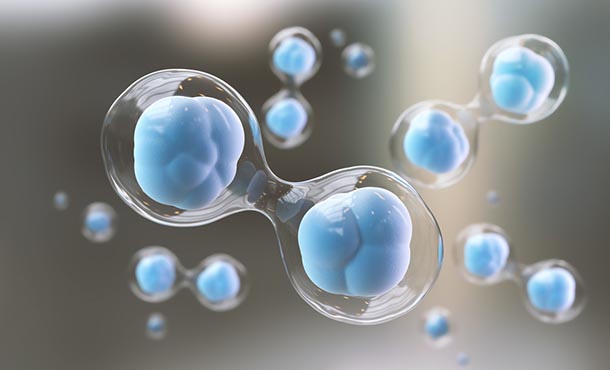
The challenge of reproducing adult stem cells plagues the regenerative medicine industry. Penn State biomedical engineering researchers seek to find solutions through computer modeling. IMAGE: ISTOCK/@ANUSORN NAKDEE
Researchers awarded $1.5M to create stem cell predictive model
2/11/2021
By Mariah Chuprinski
UNIVERSITY PARK, Pa. — Stem cells are the building blocks of the body, according to Penn State researchers. Though similar to one another at their origins, stem cells take on unique characteristics as they mature, becoming specialized cells throughout the body — such as bone, muscle, ligament, tissue or other organ cells.
But mystery still shrouds the stem cell maturation process, as it currently is impossible to predict ahead of time what immature stem cells will become.
With a $1.5 million grant from the National Science Foundation’s Reproducible Cells and Organoids via Directed-Differentiation Encoding program, the researchers plan to create a model capable of predicting and growing specific stem cells with increased accuracy, to the benefit of the biomanufacturing industry.
“Currently, we try to convince the stem cells to go down a particular development pathway by modulating their environment chemically and physically,” said Principal Investigator Daniel Hayes, Dorothy Foehr Huck and J. Lloyd Huck Chair in Nanotherapeutics and Regenerative Medicine and professor of biomedical engineering. “The challenge is that we don’t really understand the interplay of factors that are influencing the cells as they become complex tissues like bone or cardiac tissue. It’s like a “hail Mary’ approach — we put chemical or physical stressors on them, let them develop and hope they become the right type of cells in the correct mixture. It is not a satisfying approach for biomanufacturers.”
The researchers will create a computer model to predict the fate of immature stem cells so that biomanufacturers have more control about the types of cells they create. They also will standardize a system of environmental controls to determine the best lab conditions for growing such cells.
The research team will then test the model using real stem cells, derived from human adult fat cells obtained during liposuctions, to determine if the model works and to tweak it if necessary.
“The goal is to integrate these models with the production methods and biosensing to continually reassess and reconsider how the cells are behaving,” said Justin Pritchard, Dorothy Foehr Huck and J. Lloyd Huck Early Career Entrepreneurial Assistant Professor and assistant professor of biomedical engineering. “And as a result, we hope to create a greater level of understanding and control over cell manufacturing.”
The new predictive model also will eliminate biowaste, as the current practice is to reverse-engineer stem cells after they mature to determine how they specialized, which destroys them in the process.
The results of the research could guide therapeutic clinical applications for years to come, according to Pak Kin Wong, professor of biomedical engineering and mechanical engineering.
“The results could enable novel approaches in guiding stem cell differentiation for applications in personalized medicine and precision health,” he said.
The research results also could be a big break for the regenerative medicine industry, which implants stem cells in the body to repair damaged organs and tissues.
“A major problem for the regenerative medicine market is the reproducible manufacturing of adult stem cells,” Hayes said. “If we remove that limitation, it could make for a much bigger clinical impact.”
The Center of Excellence in Industrial Biotechnology in Penn State’s Huck Institutes of the Life Sciences will provide equipment and training for graduate students as part of this research project.



